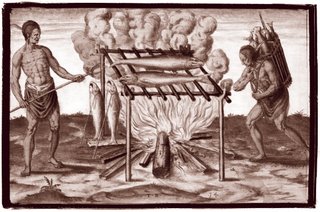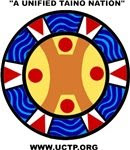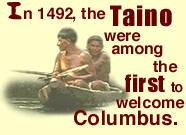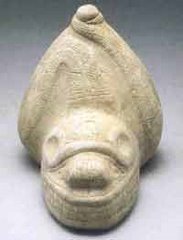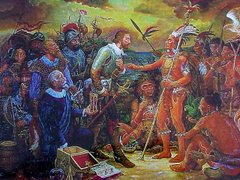Did You Know: In 1492, the official interpreter for Christopher Columbus' fleet was Luis de Torres who was a converted Jew. Torres was chosen as fleet interpreter because he spoke Hebrew and Arabic. After many attempts, Torres was unable to converse with the Taino people in Hebrew so Columbus decided to kidnap several Taino to try and teach them Spanish. One of the young Taino kidnapped was named Guaikan. He was taught to speak Spanish and became the interpreter for the expedition. Guaikan became Cristobol Colón's (Christopher Columbus) adopted Taino son. He took the name Diego Colón and sailed with Columbus on his subsequent voyages. – UCTP Taino News © 2010
Monday, November 01, 2010
Tuesday, October 12, 2010
More than one Agueybana
Did You Know: The Taino ‘name’ Agueibana (Agueybana) is related to more than one indigenous historical figure. In the 15th century, among those persons recorded with the name Agueybana in Boriken (Puerto Rico) were 'Agueybana the elder', the leader who entered into guaitiao (making relations ceremony) with Ponce de Leon and 'Agueybana el Bravo' , the leader who led a latter attack against Spanish forces. Along with these two Kasike (leaders), there are at least two naboria (local people), Martinicio and Perico, who carried the 'name' Agueybana. They were documented within the encomienda system in Boriken. There is also a record of another leader named Francisco Agueybana residing in Kiskeia (Dominican Republic) during the same time period as those who were recorded in Boriken. - UCTP Taino News © 2010
Labels:
Agueybana,
encomienda,
Guaitiao,
Kiskeya,
naboria
Monday, September 06, 2010
Jamaican Jerk
Did You Know: The culinary style known as "Jamaican jerk" refers to a method of slow cooking meat, traditionally seasoned with or cooked over the wood of the pimento (allspice). The use of ahi (aji), the Taino word for pepper, pronounced "ah-hee," is another signature ingredient with "Scotch bonnet peppers" among the most widely used. Additional spices were also incorporated and dry-rubbed or marinated into the meat. Locally, this tradition is said to go back more than 1,200 years to when indigenous Taino Peoples, the island's original inhabitants, used these methods before cooking the marinated meats over a type of wooden grate called barbakoa. From this Taino term, the English word barbecue originates. The term jerk is said to originate from the word charqui, an indigenous word of Quechua origin for dried meat, which was incorporated into Spanish, eventually becoming jerky in English. -- UCTP Taino News © 2010
Monday, August 09, 2010
The Taino Duho and UNESCO...
 Did You Know: In 1997, UNESCO had an ongoing project, Insula 2000, and chose this opportunity to strike a medal in memory of the Taino, awarded to individuals who have distinguished themselves in the defense of peace and democracy in Latin America and the Caribbean. The obverse side features a duho, a low four-legged ceremonial chair sculpted from a guaiakan tree native to the many Caribbean islands. Dating back from the 12th to the 14th century, the masterpiece of Taino art displayed on the UNESCO medal is currently in the possession of the Musée de l’Homme in Paris. According to Taino understanding the carved effigy represents a particular Spirit or "Cemi" endowed with the faculty of "moving". During ceremonial rituals, entranced spiritual leaders or community leaders called Kasike sit on the duho and “travel” to dialogue with the Spirit World. On non-religious occasions, a distinguished guest can be invited to sit on this chair which, for UNESCO, symbolizes cultural exchanges and understanding between peoples. The reverse of the medal is plain. - - UCTP Taino News © 2010
Did You Know: In 1997, UNESCO had an ongoing project, Insula 2000, and chose this opportunity to strike a medal in memory of the Taino, awarded to individuals who have distinguished themselves in the defense of peace and democracy in Latin America and the Caribbean. The obverse side features a duho, a low four-legged ceremonial chair sculpted from a guaiakan tree native to the many Caribbean islands. Dating back from the 12th to the 14th century, the masterpiece of Taino art displayed on the UNESCO medal is currently in the possession of the Musée de l’Homme in Paris. According to Taino understanding the carved effigy represents a particular Spirit or "Cemi" endowed with the faculty of "moving". During ceremonial rituals, entranced spiritual leaders or community leaders called Kasike sit on the duho and “travel” to dialogue with the Spirit World. On non-religious occasions, a distinguished guest can be invited to sit on this chair which, for UNESCO, symbolizes cultural exchanges and understanding between peoples. The reverse of the medal is plain. - - UCTP Taino News © 2010Tuesday, July 20, 2010
The Traditional Taino Diet
 Did You Know: The traditional diet of the Taino was based mainly on community cultivated agricultural products, supplemented with wild fruits as well as fishing, and limited hunting. Root tubers such as yuka (manioc) and batata (sweet potatoes) were cultivated along with many other diverse food crops like maisi (corn), mani (peanuts), calabasa (pumpkin), iaiama (pineapple), cahuil (cashews), beans, aji (peppers) etc. The hunting of small game such as birds, small mammals, and reptiles such as iguanas, and snakes was also practiced daily by community members. The ocean and rivers were also exploited in a sustainable manner for their bountiful resources. The Taino harvested edible marine-life, including conch, oysters, lobsters, clams, and crabs. Fish were caught with bone and shell hooks, large mesh nets, nasa (fish traps), spears, and bows and arrows. Some of the larger marine-life that the Taino encountered and hunted included the manati (sea cow), tuna, sea turtles, and sharks. Occasionally, even a pilot whale was taken for by various communities. Taino survival was secured by the application of ancient traditional knowledge, which included practical and medicinal knowledge of plants, an deep understanding and symbiotic relationship with their environment, and the ability to apply appropriate tools and techniques. - UCTP Taino News © 2010
Did You Know: The traditional diet of the Taino was based mainly on community cultivated agricultural products, supplemented with wild fruits as well as fishing, and limited hunting. Root tubers such as yuka (manioc) and batata (sweet potatoes) were cultivated along with many other diverse food crops like maisi (corn), mani (peanuts), calabasa (pumpkin), iaiama (pineapple), cahuil (cashews), beans, aji (peppers) etc. The hunting of small game such as birds, small mammals, and reptiles such as iguanas, and snakes was also practiced daily by community members. The ocean and rivers were also exploited in a sustainable manner for their bountiful resources. The Taino harvested edible marine-life, including conch, oysters, lobsters, clams, and crabs. Fish were caught with bone and shell hooks, large mesh nets, nasa (fish traps), spears, and bows and arrows. Some of the larger marine-life that the Taino encountered and hunted included the manati (sea cow), tuna, sea turtles, and sharks. Occasionally, even a pilot whale was taken for by various communities. Taino survival was secured by the application of ancient traditional knowledge, which included practical and medicinal knowledge of plants, an deep understanding and symbiotic relationship with their environment, and the ability to apply appropriate tools and techniques. - UCTP Taino News © 2010
Labels:
aji,
batata,
Caribbean Indigenous Peoples,
cashew,
iguana,
manati,
mani,
pineapple,
Taino,
Taino words,
UCTP Did You Know Files,
UCTP Taino News,
yuca
Tuesday, June 22, 2010
BOHIO is Taino

Did You Know: The word "Bohio" is the Taino language term for "home." Among rural communities in the Greater Antilles especially, the word bohio is still used today interchangeably with the word "casa" in Caribbean Spanish. When Columbus landed in the Dominican Republic in 1492 some of the Taino he met simply referred to their island paradise as “bohio” meaning their home. A typical community dwelling which varied in size, a bohio was made from local hardwood trees and usually retained a conical roof that was thatched with the Royal Palm. Early explorers were quite amazed that these seemingly simple round house structures could even withstand the intense tropical storms the Taino called "hurakan". - UCTP Taino News © 2010
Labels:
1492,
Bohio,
Columbus,
Dominican Republic,
Greater Antilles,
Taino words,
UCTP Taino News
Thursday, May 27, 2010
Haiti is a Taino Word
Did You Know: Haiti is one of the ancient Taino names for the island the Spaniards named Hispaniola, which is today spilt between what is now the Dominican Republic and Haiti. Other words include Ayiti, Kiskeia, and Bohio. Haiti is said to mean "Highlands." - UCTP Taino News © 2010
Labels:
Dominican Republic,
Haiti,
Hispaniola,
Taino,
UCTP Taino News
Sunday, April 18, 2010
Guarokuia

Did You Know: In 1519 on the island of Kiskeia (Dominican Republic) a Kasike named Guarokuia led a rebellion against the Spanish colonizers that lasted until 1533. As a result of this major defeat for the Spanish Crown the first treaty between Indigenous Peoples and a European Power was signed in the Western hemisphere. Guarokuia and several thousand other Taino were given lands in the area known as Boya. Much earlier Guarokuia's father had died in a Spanish raid against a non-violent Indian demonstration in Jaragua and he was raised in a monastery in Santo Domingo where he received his Christian name Enriquillo. One of his mentors was Bartolome de las Casas. Guarokuia was a nephew of Kasike Anacaona and the heir to the hereditary cheifdom of Jaragua. Guarokuia also had a wife, called Mencía, later Doña Mencía due to his relations with the Spaniards. Mencia was raped by a Spaniard named Andrés de Valenzuela and when Guarokuia attempted to take the offense to the Spanish courts, he was told nothing could be done since it was the word of an Indian woman (Mencia) against that of a Spaniard. Seeing that his situation had no recourse he lead a group of loyal followers into the Bahoruco mountains and this began his historic war against the Spaniards. In 1882 a 91-year-old woman by the name of Josefa Gonzalez, who along with other neighbors affirmed that Kasike Guarokuia (Enriquillo) and his wife Mencia were buried in a tomb in the center of the church in the town of Boya. In a related story, General Don Pedro Santana who after being elected President of the Dominican Republic, assigned a pension to an "Indian" woman of Boya claiming to be a descendant of one of the other chiefs under Enriquillo. - UCTP Taino News © 2010
Thursday, March 25, 2010
Iaiama: The Pineapple
 DID YOU KNOW - The pineapple was spread by Indigenous Peoples up through South and Central America to the Caribbean before Columbus arrived. It is suggested that the fruit was originally developed in southern Brazil and Paraguay where wild relatives occur. In 1493 Columbus encountered the fruit on the island of Guadaloupe and carried it back to Spain. The pineapple was soon distributed around the world on sailing ships that carried it for protection against scurvy. The Spanish introduced it into the Philippines and possibly to Hawaii and Guam early in the 16th Century. The pineapple reached England in 1660 and began to be grown in greenhouses around 1720. In the Taino language the pineapple is called Iaiama (Yayama). – UCTP Taino News © 2010
DID YOU KNOW - The pineapple was spread by Indigenous Peoples up through South and Central America to the Caribbean before Columbus arrived. It is suggested that the fruit was originally developed in southern Brazil and Paraguay where wild relatives occur. In 1493 Columbus encountered the fruit on the island of Guadaloupe and carried it back to Spain. The pineapple was soon distributed around the world on sailing ships that carried it for protection against scurvy. The Spanish introduced it into the Philippines and possibly to Hawaii and Guam early in the 16th Century. The pineapple reached England in 1660 and began to be grown in greenhouses around 1720. In the Taino language the pineapple is called Iaiama (Yayama). – UCTP Taino News © 2010
Labels:
Guadaloupe,
Iaiama,
pineapple,
Taino,
Taino Nation,
Yayama
Thursday, February 04, 2010
Canadian First Nations Recognize Taino Treaty
DID YOU KNOW - A peace treaty signed in 1533 in the Caribbean between Taino Kasike Guarokuia (Enriquillo/Henri) and a representative of the King of Spain was recognized as the “first international treaty in the Americas between Indigenous people and Europeans" in a resolution by over 100 delegates to the Assembly of First Nations (AFN) National Treaty Conference, held in Yellowknife, Northwest Territories on Oct. 28, 1998. The AFN resolution recommended recognition of the Taino-Spanish treaty to the United Nations rapporteur, Miguel Alfonso Martinez of Cuba, who was completing his final report on treaties with Indigenous peoples around the world. One fourth of Canada's Indian chiefs attended the conference, which discussed national and international treaty implications and strategies. The resolution, moved by Akaitcho Territory Government Grand Chief Felix Lockhart and seconded by Chief Fred Sangris (Yellowknives Dene), reads in part: "AFN recommends that the "1533 Bahoruco Treaty” be recognized as the first Treaty in the Americas between Indigenous Peoples and Europeans in the Final Report of the U.N. Special Rapporteur.” - UCTP Taino News © 2010
Friday, January 15, 2010
Taino Recognition

DID YOU KNOW: The United Confederation of Taino People is recognized by the U.S. Congress, U.S. Census Bureau, USA.gov, and several U.S. State and local governments and agencies. In Boriken (Puerto Rico), the Confederation is recognized by the Municipality of Utuado and the Puerto Rican House of Representatives. The work of Confederation is recognized by the Government of Canada and by inter-governmental organizations such as the United Nations and Organization of American States (OAS). In the promotion of indigenous Taino sovereignty, the UCTP has also entered into treaties with Caribbean Indigenous Governments and Tribal Organizations in Dominica, Trinidad, Barbados, and Bermuda as well as with related South American mainland communities in Venezuela and Guyana. - UCTP Taino News ©2010
Subscribe to:
Comments (Atom)

